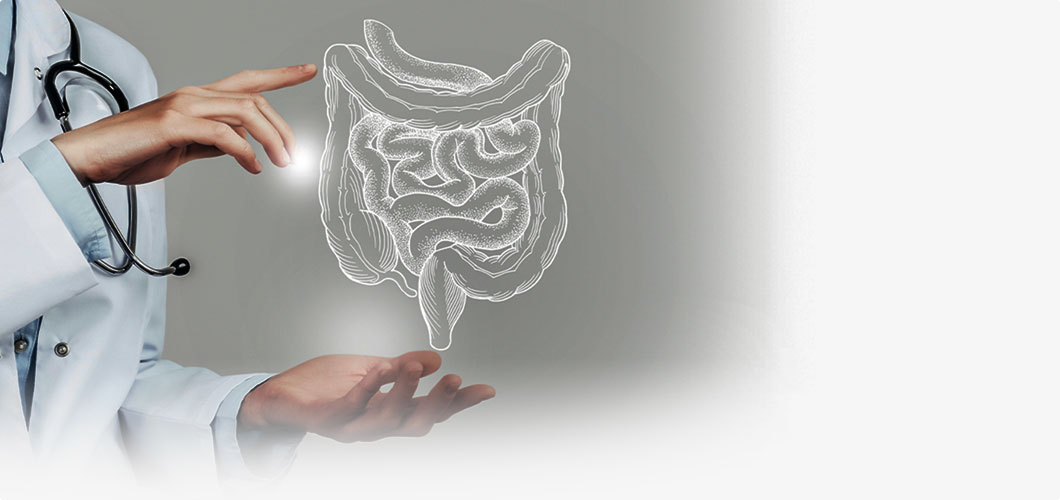Speak to us
For any enquiries, please call us at any of our clinics.
Orchard
Farrer Park

What is an Ostomy?
An ostomy is an opening created surgically for bodily waste products, such as faeces, to leave the body. This new opening (stoma) facilitates a connection from the intestines all the way through to protruding outside of the abdomen. Stomas can either be temporary or permanent, depending on the patient’s condition. For temporary stomas, the patient will undergo an ostomy reversal procedure to reconnect the intestine.
TYPES OF STOMAS
ILEOSTOMY
An ileostomy is created when a portion of the small intestine, known as the ileum, is brought to the surface of the abdomen. An ileostomy is usually located at the lower-right abdomen and bowel movements are generally constant and watery, containing high volumes of salts and digestive enzymes. This is usually done after low rectal cancer surgeries, or sometimes after emergency intestine operations.
COLOSTOMY
A colostomy is created when a portion of the large intestine, also known as the colon, is brought up to the surface of the abdomen. Sometimes, a colostomy is created to promote healing after part of the colon has been removed. For some conditions such as cancer involving the anus, the colostomy is permanent after the anus has been removed.
CARING FOR YOUR STOMA
Once an ileostomy or colostomy is created, patients will need to undergo stoma training which will be provided by the nurses before they are discharged home. We will advise the appropriate pouching system based on your stoma and bowel movements. Skin care and nutrition advice will also be given.
Emptying/Pouch System
+
- Here are some of the requisites for emptying and/or changing of stoma bags, depending on the pouch system used:
- Marker pen
- Pair of scissors
- Measuring guide
- Moistened wipes/paper towel
- Stoma paste or strip paste
- Skin care powder and/or spray designed specifically for stomas
- Pouch system - One-piece or two-piece system
- Always wash your hands before and after changing the pouch system. You may choose to put on gloves.
- Empty the contents into the toilet several times a day or when the bag is 1/3 or 1/2 full. Emptying on a regular basis can help avoid a bulge that may be visible under your clothes.
- Depending on the pouch system you use and the characteristics of your stools, bag changes are usually scheduled every 3 to 7 days.
- Periodic adjustments to your product choices may be needed as the initial swelling subsides and stoma size changes up to 10 weeks after surgery.
Diet & Nutrition
+
- Immediately after surgery, patients will need to be on low fibre diet for 6 to 8 weeks.
- Thereafter, you can gradually resume eating a balanced diet as there are no set dietary restrictions with stoma patients.
- Eating regularly and drinking plenty of water is recommended.
- Chewing your food thoroughly helps with better digestion.
- If you are experiencing diarrhoea, omit foods high in fibre and bulk such as whole grains, high fibre bread and fried foods. Instead, take more foods such as rice, pasta, potatoes without skin to thicken your stool.
- If you find your stoma output is too hard, consider drinking more water and fruit juices to increase your fluid intake and prevent constipation. Include vegetables and fresh fruits as well as fibrous foods such as wholegrain bread.
- Foods that upset your stomach before surgery may have a similar effect post-surgery. Avoid foods from your diet if you experience discomfort such as bloating and pain after eating it.
Odour & Gas Control
+
- Most pouching systems have a built-in charcoal filter to help with reducing odour and allowing wind to be released.
- Avoid drinking through a straw, talking while eating and smoking as these will cause more production of intestinal air.
- Some foods are known to produce odour and gas. It is best to avoid such foods as excessive gas may cause the bag to be filled up more frequently.
- Examples of odour-producing foods: Eggs, garlic, spices, fish, and alcohol.
- Examples of gas-producing foods: Carbonated drinks, dairy products, onion, cabbage, beans.
- There is usually a delay between eating gas-producing foods and flatulence, which is about six hours for a person with colostomy.
- Ballooning can occur if the filter capacity cannot manage the amount of gas produced, or if the filter has become moist or obstructed by the stoma output.
- If ballooning occurs, you can release gas from the pouch in the privacy of a toilet.
- There are various forms of products specifically made for stoma bags to control odour or solidify output.
Skin Care
+
- It is important to maintain healthy peristomal (skin around the stoma) skin as it can be painful and distressing to have damaged skin.
- Skin infections or irritations may occur when there is leakage of stoma output, either from an improperly fitting pouch system or from removing the pouch too often.
- Patients can shower as per normal with or without the pouch system, as water and soap will not damage the stoma. However, it is recommended to avoid oil-based and moisturising soap.
- Choose a well-fitting base plate and make sure the peristomal skin is not exposed to the stoma output.
- Ensure that the skin is completely dry before applying new baseplate adhesives or pouch.
- Do not rip or tear off adhesives as it may damage the peristomal skin. Instead, consider using adhesive removal spray or wipes.
- Consider routine skin care to preserve healthy peristomal skin and comfort.
Medication
+
- Following ostomy surgery, drug digestion and absorption may need to be altered, either alone or in combination.
- Some drugs may not be completely absorbed by your body if you have an ileostomy. As your intestines are shorter, some drugs are absorbed slowly or in the lower portion of the intestines.
- Urine or stool colour may change with certain medications and food. The form of the medication may need to be adjusted to promote better absorption.
- For sustained-release, enteric-coated medications, and laxatives, it is better to check with our doctor before consuming them.
Lifestyle
+
- Avoid lifting or pushing anything more than 5kg during the first 6 to 8 weeks post-surgery.
- After recovering and feeling stronger, you can go back to most sports with your doctor’s permission.
- Start slow and listen to your body. Do not take part in strenuous activities such as rough contact sports for 2 to 3 months post-surgery, as it increases the risk of developing hernias (bulging of an organ or tissue) through your wound or stoma.
- Most pouch systems are water-resistant, so you can even go for activities like swimming!
- Empty your pouch before exercising and you may wish to wear an opaque pouch to reduce visibility through clothing.
- You may resume work and travel as soon as you feel ready and approved by doctor.
- If you are travelling, be sure to bring along your supplies (enough to last if you are expected to stay longer) and plan in advance so you feel prepared.
- Sexual activities will not affect hurt the stoma if no excessive pressure is placed on it.
Importantly, seek help if you have the following symptoms:
- Nausea and vomiting
- Abdominal bloating, cramping and distended abdomen
- Watery stoma output, or no output at all
- Decreased urine output
- Dark amber coloured or concentrated urine
- Light-headedness
- Swelling of the stoma
- Persistent leakage of the stoma
- Skin complications from the stoma
Website maintained by Activa Media. All Rights Reserved.





